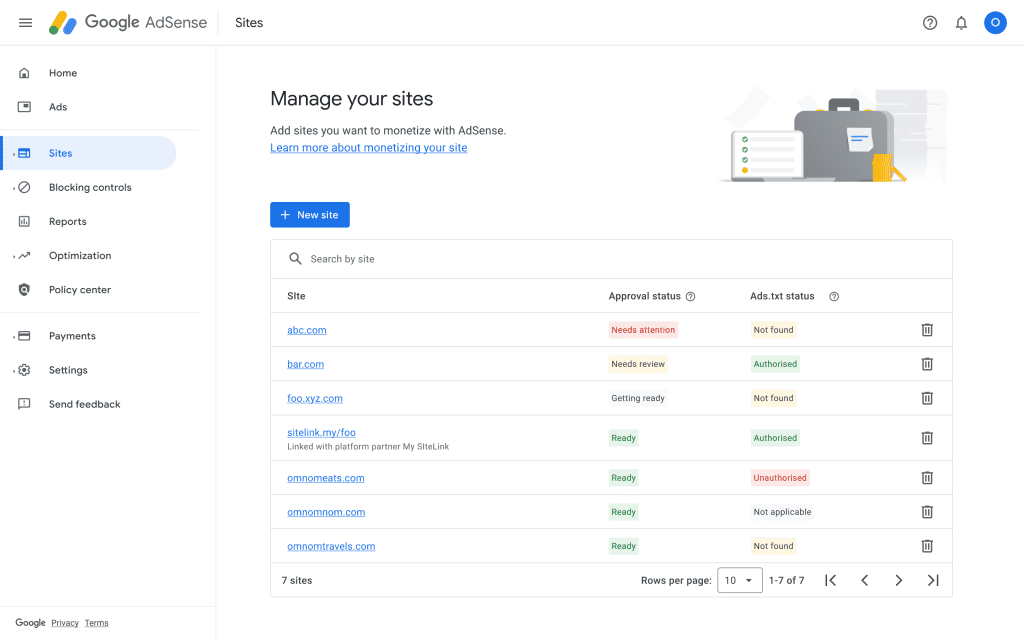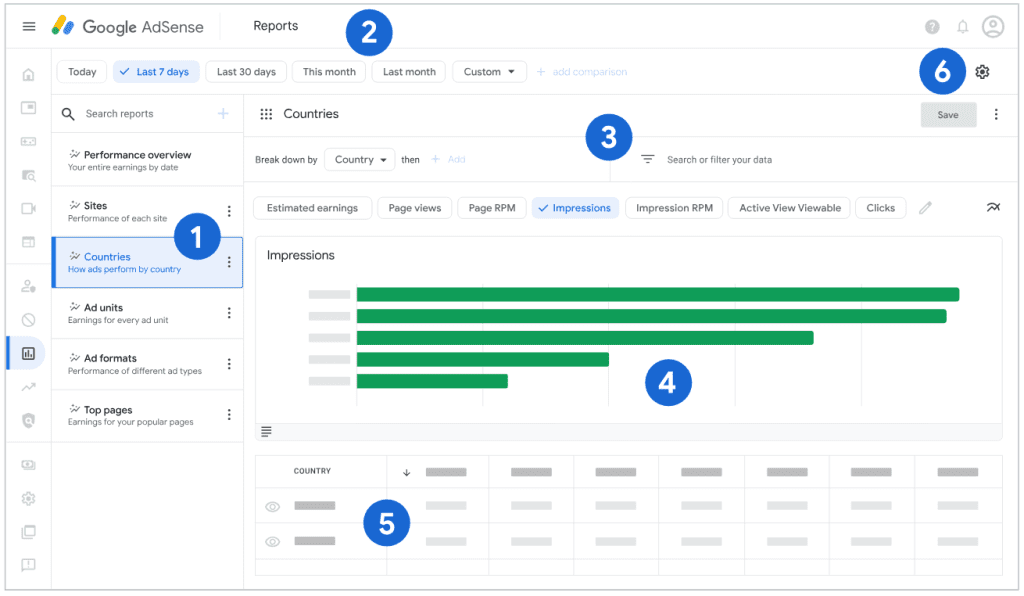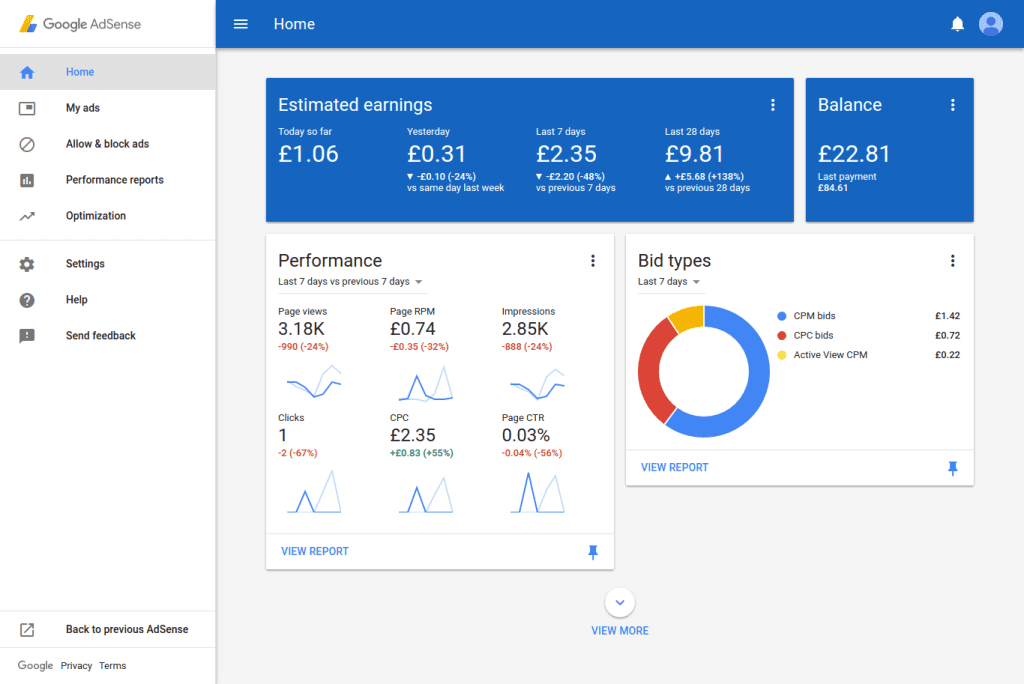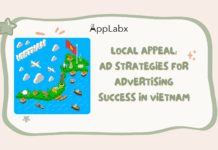Key Takeaways
- Monetize Strategically: Learn how Google AdSense facilitates strategic monetization, allowing publishers to optimize ad formats, placements, and user experience for increased revenue.
- Data-Driven Insights: Gain valuable insights into key performance indicators (KPIs) like CTR, CPC, and CPM, empowering you to make informed decisions and continually refine your advertising strategies.
- User-Centric Revenue: Understand the synergy between user experience and revenue generation, discovering how a seamless blend of quality content, strategic ad placement, and compliance with AdSense policies can create a flourishing online income stream.
In the vast landscape of online monetization, one platform stands out as a beacon for publishers seeking to transform digital real estate into revenue: Google AdSense.
This comprehensive guide aims to demystify the intricate workings of Google AdSense, offering a roadmap for both novices and seasoned publishers to navigate this powerful advertising tool effectively.
From unraveling the fundamental concepts to exploring the nuances of ad formats and auction processes, we embark on a journey to understand the core mechanics that fuel income generation through Google AdSense.

Defining Google AdSense: A Cornerstone of Digital Monetization
At the heart of countless online success stories lies Google AdSense—a robust advertising platform that has become synonymous with turning website traffic into tangible revenue.
To comprehend its role in the vast ecosystem of digital advertising, it’s essential to grasp the fundamentals.
Google AdSense is not just a tool; it’s a strategic partner for publishers, connecting them with advertisers in a dynamic marketplace.
As we delve into the intricacies of its features and unique benefits, we unravel why Google AdSense has become the go-to choice for publishers worldwide.
Deconstructing the AdSense Ecosystem: How the Pieces Fit Together
Understanding the mechanics of Google AdSense requires a closer look at the ecosystem that powers the advertisements we see on websites.
Publishers and advertisers play pivotal roles in this dynamic exchange, collaborating within the framework of AdSense to create a symbiotic relationship.
This section dissects the ad auction process, shedding light on the intricacies of bidding, ad formats, and strategic placement options.
By the end, you’ll not only comprehend the inner workings of AdSense but also appreciate how it maximizes revenue potential for publishers.
Eligibility and Sign-Up: Navigating the Gateway to AdSense Profits
Embarking on the journey of AdSense monetization begins with understanding the eligibility criteria and navigating the sign-up process.
This section serves as a practical guide, outlining the qualifications publishers need to meet and offering a step-by-step walkthrough on creating an AdSense account.
Whether you’re a content creator or a website owner, this information is crucial for optimizing the approval process and setting the stage for lucrative opportunities with Google AdSense.
AdSense Policies and Guidelines: Navigating the Regulatory Landscape
Success with Google AdSense hinges on compliance with its policies and guidelines.
This segment explores the regulatory landscape, providing an overview of content policies, ad placement guidelines, and actionable tips to avoid common pitfalls.
By the end, you’ll not only understand the do’s and don’ts but also possess the knowledge to create a digital space that aligns seamlessly with AdSense requirements, ensuring sustained monetization without disruptions.
Maximizing Earnings: Crafting Strategies for Optimal Performance
The key to unlocking the full potential of Google AdSense lies in maximizing earnings through strategic planning.
This section dives into effective ad placement strategies, optimization of ad formats, and the overarching importance of high-quality content and user experience.
As publishers, the insights shared here will empower you to create an environment where ads not only generate revenue but also enhance the overall user experience, fostering long-term success.
Monitoring and Analyzing Performance: Decoding the Metrics that Matter
To thrive in the world of AdSense, publishers must become adept at monitoring and analyzing performance metrics.
Navigating the AdSense dashboard, understanding key indicators, and utilizing reports and analytics tools are integral aspects covered in this segment.
Armed with this knowledge, publishers can make informed decisions, fine-tune their approach to achieve optimal results, and continually refine their strategies for sustained revenue growth.
Troubleshooting Common Issues: Overcoming Hurdles on the Path to Profits
No journey is without its challenges, and the path to AdSense’s prosperity is no exception.
This section serves as a troubleshooter’s guide, addressing common issues such as low earnings, ad serving glitches, and policy violations.
By providing practical solutions, it equips publishers to navigate obstacles confidently, ensuring a smooth and uninterrupted flow of revenue through their AdSense endeavors.
Charting a Course for AdSense Prosperity
In the concluding segment, we recap the key takeaways, encouraging publishers to embark on their AdSense journey with newfound knowledge and confidence.
This comprehensive guide serves as a compass, guiding you through the intricate landscape of Google AdSense and empowering you to turn website traffic into a lucrative revenue stream.
As you apply the insights gained here, remember that the world of AdSense is dynamic, and success lies in continual adaptation and innovation. Here’s to unlocking the full potential of Google AdSense and charting a course for sustained digital prosperity.
But, before we venture further, we like to share who we are and what we do.
About AppLabx
From developing a solid marketing plan to creating compelling content, optimizing for search engines, leveraging social media, and utilizing paid advertising, AppLabx offers a comprehensive suite of digital marketing services designed to drive growth and profitability for your business.
AppLabx is well known for helping companies and startups use advertising to drive web traffic to their websites and web apps.
At AppLabx, we understand that no two businesses are alike. That’s why we take a personalized approach to every project, working closely with our clients to understand their unique needs and goals, and developing customized strategies to help them achieve success.
If you need a digital consultation, then send in an inquiry here.
What is Google AdSense and How It Works to Make Money
- Understanding Google AdSense
- How Google AdSense Works
- AdSense Policies and Guidelines
- Maximizing Earnings with Google AdSense
- Monitoring and Analyzing Performance
1. Understanding Google AdSense
Unlocking the full potential of Google AdSense begins with a deep understanding of its core principles, features, and the intricate mechanisms that drive its success.
In this section, we delve into the foundations of Google AdSense, exploring its purpose, key features, and what sets it apart in the realm of online advertising.

Defining Google AdSense: A Strategic Revenue Partnership
Google AdSense is not just an advertising platform; it’s a strategic partnership that connects publishers with advertisers in a dynamic marketplace.
Publishers, in this context, are individuals or organizations that own digital real estate, such as websites or blogs.
Advertisers, on the other hand, are businesses seeking to promote their products or services.
Google AdSense acts as the intermediary, allowing advertisers to bid for ad space on publishers’ digital properties.
Key Features and Benefits of Google AdSense
- Contextual Targeting: One of the standout features of AdSense is contextual targeting. Advertisements displayed are dynamically matched to the content of the webpage, ensuring a higher relevance to the audience.
For example, if a user is reading a fitness article, AdSense may display ads related to health supplements or workout equipment. - Wide Range of Ad Formats: AdSense supports various ad formats, including display ads, text ads, and link units. This versatility enables publishers to choose the format that best integrates with their content and engages their audience effectively.
- Global Reach: With a vast network of advertisers and publishers, Google AdSense facilitates global reach. Advertisers can target audiences across different regions, expanding their reach, while publishers can monetize their content on a global scale.
Differentiating Factors from Other Advertising Platforms
- Auction-Based System: Google AdSense operates on a real-time auction system where advertisers bid for ad space. This auction mechanism ensures that the highest bidder’s ad gets displayed, maximizing revenue potential for publishers.
- Automated Optimization: AdSense utilizes machine learning algorithms to automatically optimize ad placements based on user behavior and content relevance. This automated optimization enhances the user experience and maximizes revenue for publishers.
- Comprehensive Analytics: Google AdSense provides detailed analytics, allowing publishers to track performance metrics such as click-through rates, impressions, and earnings.
This data empowers publishers to make informed decisions and refine their strategies for better results.- Over 2 million publishers were using Google AdSense globally, showcasing its widespread adoption.
AdSense in Action: How It Works at a Micro Level
To understand Google AdSense fully, it’s crucial to comprehend the micro-level processes that govern ad serving, bidding, and the ultimate display of advertisements on publishers’ websites.
Publisher and Advertiser Roles
- Publisher’s Role: Publishers sign up for AdSense and provide ad space on their digital properties. They integrate ad codes into their website, allowing Google to display relevant ads to their audience.
- Advertiser’s Role: Advertisers create ads and bid for ad space through the AdWords platform. Advertisers specify the target audience, budget, and bid amount for each ad campaign.
Ad Formats and Placement Options
- Display Ads: These are visual ads that can include images, animations, or multimedia. They can be placed in various sizes and positions on a webpage, enhancing visibility and engagement.
- Text Ads: Simple, text-based ads that blend seamlessly with the content of a webpage. They are often placed within articles or between paragraphs for a non-intrusive user experience.
- Link Units: These are sets of links that, when clicked, lead users to a page of related topics. Link units are an additional way for publishers to provide relevant content to their audience while generating revenue.
Ad Auction Process and Bidding Mechanics
- Real-Time Bidding (RTB): AdSense operates on a real-time bidding system, where advertisers bid for ad impressions in milliseconds as a user loads a webpage. The highest bidder’s ad is then displayed to the user.
- The global real-time bidding market size reached US$ 12.8 billion in 2022 and it is expected to reach US$ 43.8 billion by 2028, highlighting the prevalence and growth of this bidding mechanism.
- Quality Score and Ad Rank: Advertisers not only bid for ad space, but Google also considers the quality and relevance of the ad.
The Quality Score, determined by factors like ad relevance and landing page experience, influences the Ad Rank, which determines the ad’s position on a webpage.
2. How Google AdSense Works
Understanding the intricacies of how Google AdSense functions is essential for publishers aiming to maximize their revenue potential.
This section provides an in-depth exploration of the processes that govern Google AdSense, from the initial ad auction to the display of ads on publishers’ websites.

Overview of the AdSense Ecosystem
- AdSense as an Intermediary: Google AdSense operates as a bridge between publishers and advertisers, facilitating a seamless exchange in the digital advertising ecosystem.
Advertisers use Google Ads (formerly known as AdWords) to create and manage ad campaigns, while publishers integrate AdSense into their websites to monetize traffic. - Real-Time Auction System: At its core, Google AdSense functions on a real-time auction system. When a user visits a webpage, an ad auction takes place in milliseconds, where advertisers bid for the opportunity to display their ads to that specific user.
Publisher and Advertiser Roles in the AdSense Ecosystem
- Publisher’s Role:
- Publishers are individuals or entities that own digital properties, such as websites or blogs.
- They sign up for Google AdSense, gaining access to a user-friendly platform where they can manage ad settings, track performance, and receive payments.
- There are 40 million sites with AdSense.
- Example: A blogger specializing in technology may integrate AdSense into their blog to monetize the traffic generated by their informative articles.
- Advertiser’s Role:
- Advertisers create ad campaigns using Google Ads, specifying the target audience, budget, and bidding strategy.
- They bid for ad space in the real-time auction, competing with other advertisers to have their ad displayed to a particular user.
- The average click-through rate in Google Ads across all industries is 3.17% for search and 0.46% for display.
- Example: An e-commerce business selling fitness equipment may create a Google Ads campaign targeting users interested in health and fitness.
Ad Formats and Placement Options in Google AdSense
- Display Ads:
- These visually appealing ads can include images, animations, or multimedia.
- Publishers have the flexibility to choose the size and position of display ads on their web pages.
- Example: An online fashion magazine may integrate display ads showcasing the latest clothing trends within its articles.
- Text Ads:
- Simple, text-based ads that seamlessly blend with the content of a webpage.
- They are often placed within articles or strategically positioned to enhance user engagement.
- Example: A finance blog may incorporate text ads related to investment services within its educational articles.
- Link Units:
- Sets of links that, when clicked, lead users to a page of related topics.
- Link units offer an additional way for publishers to provide relevant content to their audience while generating revenue.
- Example: A cooking website may utilize link units to guide users to pages with recipes based on specific cuisines.
Ad Auction Process and Bidding Mechanics
- Real-Time Bidding (RTB):
- AdSense’s real-time bidding system allows advertisers to bid for ad impressions in milliseconds as a user loads a webpage.
- The highest bidder’s ad is then displayed to the user.
- Quality Score and Ad Rank:
- Google considers the quality and relevance of ads alongside the bid amount.
- The Quality Score, influenced by factors like ad relevance and landing page experience, determines the Ad Rank, which dictates the ad’s position on a webpage.
- Example: An advertiser with a high-quality ad promoting eco-friendly products may achieve a lower CPC and a prime ad position.
3. AdSense Policies and Guidelines
Understanding and adhering to the policies and guidelines set forth by Google AdSense is a crucial aspect of a publisher’s journey to sustainable and compliant revenue generation.
In this comprehensive guide, we explore the intricate details of AdSense policies, covering content guidelines, ad placement regulations, common pitfalls, and practical tips to ensure publishers maintain a healthy and profitable relationship with the platform.

Content Policies: Upholding Quality and Relevance
- Content Quality and Originality:
- AdSense emphasizes the importance of high-quality, original content on websites.
- Publishers should avoid duplicate or scraped content and focus on providing valuable and unique information to their audience.
- Example: A recipe blog should ensure that each recipe is accompanied by original and detailed content, avoiding duplication from other sources.
- Prohibited Content Categories:
- AdSense has strict guidelines regarding prohibited content categories, including illegal content, violence, hate speech, and adult content.
- Publishers must refrain from hosting or promoting content that falls within these prohibited categories.
- Example: A news website should exercise caution and diligence to prevent the inclusion of any hate speech or violent content in its articles.
Ad Placement Guidelines: Ensuring a Positive User Experience
- Avoiding Misleading Ad Placement:
- Publishers are required to place ads in a manner that does not mislead users or interfere with the navigation of a website.
- Placing ads under drop-down menus or using deceptive tactics to encourage clicks is strictly against AdSense policies.
- Example: A lifestyle blog should refrain from placing ads in a way that could confuse users, making them believe that the ad is part of the main content.
- Balancing Content and Ads:
- AdSense policies discourage the excessive use of ads on a page, ensuring a balance between content and advertising.
- Publishers should avoid overwhelming users with a high density of ads that may detract from the overall user experience.
- Example: A tech review site should strategically place ads to complement its content without overwhelming readers.
Common Reasons for Policy Violations and How to Avoid Them
- Deceptive Click Practices:
- Publishers must refrain from engaging in deceptive practices that artificially inflate ad clicks.
- Encouraging users to click on ads or implementing mechanisms that generate invalid clicks can lead to policy violations.
- Example: An online quiz platform should ensure that users are not misled into clicking on ads while engaging with quiz content.
- Invalid Clicks and Impressions:
- Publishers should actively prevent invalid clicks and impressions, which include artificial clicks or impressions generated to increase revenue.
- Utilizing automated click-generating tools or encouraging users to repeatedly click on ads is strictly against AdSense policies.
- Example: A mobile gaming website should discourage users from engaging in practices that artificially inflate ad impressions.
Tips for Optimizing AdSense Compliance
- Regularly Review and Update Policies:
- Stay informed about any updates or changes in AdSense policies by regularly reviewing the official AdSense Help Center.
- Google may update policies to adapt to evolving industry standards and user expectations.
- Utilize AdSense Tools:
- Leverage AdSense tools, such as the AdSense Policy Center, to monitor and address policy violations proactively.
- The Policy Center provides personalized recommendations and insights to help publishers maintain compliance.
- Educate Content Creators:
- If managing a multi-author website, educate content creators about AdSense policies and guidelines.
- Establish clear editorial guidelines to ensure that all content aligns with AdSense requirements.
- Example: A large content platform should conduct regular training sessions for its writers on AdSense policies and content quality standards.
4. Maximizing Earnings with Google AdSense
Unlocking the full earning potential with Google AdSense requires a strategic approach that goes beyond mere implementation.
In this extensive guide, we explore effective strategies for publishers to maximize their earnings through thoughtful ad placement, optimization of ad formats, and the overarching importance of high-quality content and user experience.

Effective Ad Placement Strategies
- Strategic Positioning for Higher Visibility:
- Carefully consider the placement of ads on your website to ensure maximum visibility and engagement.
- Position ads strategically within or adjacent to high-traffic areas, such as above the fold or within content.
- Example: A travel blog may strategically place display ads showcasing travel deals above the fold, where users are more likely to notice them.
- Blend Ads with Content Seamlessly:
- Create a seamless integration of ads within your content to enhance user experience.
- Use matching colour schemes and fonts to make ads appear native and non-intrusive.
- 53% of consumers view native ads more frequently than display ads.
- Example: A cooking website can integrate text ads promoting kitchen tools within recipe articles, creating a harmonious blend with the content.
Optimizing Ad Formats for Better Performance
- Diversify Ad Formats for Enhanced Engagement:
- Experiment with various ad formats, including display ads, text ads, and link units.
- Diversification helps cater to different audience preferences and can lead to improved click-through rates (CTR).
- Example: An e-commerce website may use display ads to showcase products and text ads for limited-time promotions.
- Leverage Responsive Ad Units for Mobile Optimization:
- Ensure your website is mobile-friendly by incorporating responsive ad units.
- Responsive ads adapt to different screen sizes, providing a seamless experience for users on various devices.
- In the last quarter of 2023, mobile devices (excluding tablets) generated 58.67 per cent of global website traffic.
- Example: A news website should utilize responsive ad units to cater to the growing audience accessing content on mobile devices.
Importance of High-Quality Content and User Experience
- Create Valuable and Relevant Content:
- Focus on producing high-quality, valuable content that aligns with your audience’s interests.
- Relevant content enhances user engagement and can lead to increased ad clicks.
- Example: A finance blog providing in-depth analysis and insights on investment strategies is likely to attract a more engaged audience.
- Optimize Website Speed for Retention:
- Optimize your website’s loading speed to prevent user abandonment.
- Faster-loading pages contribute to improved user retention and increased ad impressions.
- For every second delay in mobile page load, conversions can fall by up to 20%.
- Example: An online magazine should regularly optimize images and minimize unnecessary scripts to maintain a fast-loading website.
Mobile Optimization Tips for Maximum Impact
- Implement Accelerated Mobile Pages (AMP):
- Incorporate AMP to create lightning-fast, mobile-optimized versions of your pages.
- AMP helps enhance the mobile user experience, leading to increased ad views and clicks.
- Example: A travel blog can implement AMP to ensure swift loading of content and ads, especially for users accessing the site on mobile devices.
- Use Sticky Ad Units for Persistent Visibility:
- Implement sticky ad units that remain visible as users scroll down the page.
- Sticky ads contribute to prolonged exposure, increasing the likelihood of user interaction.
- Example: A lifestyle website may use sticky ad units to display sponsored content persistently, enhancing visibility and engagement.
5. Monitoring and Analyzing Performance
Effectively monitoring and analyzing the performance of your Google AdSense account is essential for optimizing revenue and ensuring a successful advertising strategy.
In this comprehensive guide, we’ll explore the key performance indicators (KPIs), tools, and actionable insights that can empower publishers to make informed decisions and enhance their overall AdSense experience.

Essential Key Performance Indicators (KPIs) for AdSense
- Click-Through Rate (CTR):
- Definition: CTR represents the percentage of users who click on an ad after seeing it.
- Importance: A higher CTR indicates that the ads are resonating with the audience, potentially leading to increased revenue.
- Example: A lifestyle blog with a CTR of 0.8% signifies that 0.8% of users click on the ads displayed on the site.
- Cost Per Click (CPC):
- Definition: CPC measures the amount advertisers pay for each click on their ads.
- Importance: Monitoring CPC helps understand the value of clicks and how much revenue each click generates.
- The average CPC in Google Ads across industries is $2.69 for Search and $0.63 for Display.
- Example: An e-commerce website with a CPC of $3 means the site earns $3 for every click on an ad.
- Cost Per Mille (CPM):
- Definition: CPM represents the cost per thousand impressions, indicating the amount advertisers pay for a thousand ad impressions.
- Importance: CPM is crucial for publishers focusing on ad impressions rather than clicks.
- Example: A news website with a CPM of $4 means the site earns $4 for every thousand ad impressions.
Effective Use of Google AdSense Reports and Analytics
- AdSense Performance Reports:
- Utilize AdSense performance reports to gain insights into ad performance.
- These reports provide data on key metrics, including CTR, CPC, earnings, and more.
- AdSense statistics in Analytics are generally updated every 24 hours.
- Example: A publisher can use the reports to identify which ad formats or placements generate the highest CTR and adjust their strategy accordingly.
- Google Analytics Integration:
- Integrate Google Analytics with your AdSense account for a more comprehensive view of website performance.
- Google Analytics provides valuable data on user behaviour, allowing publishers to correlate ad performance with user engagement.
- Example: A blog can use Google Analytics to identify the pages with the highest user engagement and strategically place ads on those pages.
Optimizing for Viewability and Ad Placement Strategies
- Viewability Metrics:
- Definition: Viewability measures the percentage of ad impressions that are actually viewed by users.
- Importance: Higher viewability ensures that ads have the opportunity to be seen by the audience.
- An ad is counted as viewable if at least 50% of its area is visible for at least 1 second for display ads, or at least 2 seconds for video ads.
- Example: If a website has a viewability rate of 60%, it means 60% of the served ads are considered viewable.
- Strategic Ad Placement:
- Experiment with different ad placements to identify the most effective positions.
- Consider placing ads near engaging content, above the fold, or within the natural reading path.
- Example: A travel website may discover that placing display ads within travel guides results in higher viewability and engagement.
A/B Testing for Continuous Improvement
- A/B Testing Ad Formats:
- Conduct A/B tests to compare the performance of different ad formats.
- Test variations in ad sizes, types, and designs to determine which resonates best with your audience.
- Example: A technology blog may A/B test different ad formats, discovering that larger display ads generate a higher CTR.
- User Experience A/B Tests:
- Experiment with changes to your website’s layout and design to assess their impact on user experience.
- A positive user experience can lead to increased engagement and ad visibility.
- Example: A fashion website may A/B test different homepage layouts to understand which layout encourages users to explore more content and view ads.
Continuous Optimization for Sustainable Growth
- Regularly Review and Update Ad Strategies:
- Stay informed about industry trends and updates in advertising.
- Regularly review and update your ad strategies to adapt to changing user behaviours and market dynamics.
- Example: An online magazine may update its ad strategies seasonally, aligning with trends and user interests.
- Stay Compliant with AdSense Policies:
- Regularly review and ensure compliance with Google AdSense policies.
- Violations can impact ad serving and revenue generation.
- Example: A gaming blog must ensure its content adheres to AdSense policies to avoid disruptions in ad serving.
Conclusion
In the dynamic realm of digital advertising, Google AdSense stands as a beacon for publishers seeking not only to monetize their online presence but to do so strategically and sustainably.
This comprehensive exploration into “What is Google AdSense and How It Works to Make Money” has unveiled the intricate mechanisms that underpin this advertising platform and provided actionable insights for publishers aiming to maximize their revenue streams.
Empowering Publishers with AdSense Knowledge
Armed with an understanding of the AdSense ecosystem, publishers are now equipped to navigate the intricate processes that facilitate the exchange between advertisers and audiences.
The real-time auction system, where advertisers bid for ad space milliseconds before a user loads a webpage, emerges as a crucial facet of the revenue-generation journey.
By comprehending the roles of both publishers and advertisers, individuals can leverage AdSense as a powerful intermediary, connecting content creators with brands in a seamless digital dance.
Diverse Ad Formats and Placement Strategies
The exploration of various ad formats – from visually appealing display ads to subtle yet effective text ads and interactive link units – empowers publishers with the flexibility to choose the formats that resonate best with their audience.
Understanding the strategic placement of ads, whether above the fold for optimal visibility or seamlessly integrated within content, ensures that the user experience remains paramount while revenue potential is maximized.
Realizing the Power of Data and Analytics
The journey through AdSense is not a blind one; it is illuminated by data and analytics.
Key performance indicators (KPIs) such as Click-Through Rate (CTR), Cost Per Click (CPC), and Cost Per Mille (CPM) emerge as compasses guiding publishers through the vast landscape of ad performance.
The integration of Google Analytics further extends this visibility, providing a panoramic view of user behavior and engagement that goes beyond the confines of AdSense reports.
Strategic Optimization for Sustainable Growth
Optimization, a cornerstone of success in the digital realm, takes center stage as publishers delve into the nuances of viewability metrics and ad placement strategies.
The adoption of A/B testing becomes a powerful tool for continuous improvement, enabling publishers to refine their approaches based on real-world user interactions.
The importance of adapting strategies in line with industry trends, staying compliant with AdSense policies, and regularly reviewing performance metrics is underscored as the pathway to sustained growth and increased revenue.
The Intersection of User Experience and Revenue Generation:
Throughout this exploration, the symbiotic relationship between user experience and revenue generation becomes evident.
Websites optimized for speed, mobile responsiveness, and overall user satisfaction are not only magnets for audience engagement but also fertile grounds for the flourishing of advertising endeavors.
Sticky ad units, seamlessly blending with content, and strategically placed to enhance rather than interrupt the user journey, epitomize the harmonious coexistence of user-centric design and revenue-maximizing strategies.
A Continuum of Learning and Evolution
As we conclude this journey through the realms of Google AdSense, it’s crucial to recognize that this is not a destination but a continuum of learning and evolution. The digital landscape evolves, user behaviors shift, and advertising trends transform.
Publishers who embrace this perpetual learning cycle, staying attuned to industry shifts, and adapting their strategies accordingly, are poised not just for success but for leadership in the ever-evolving world of online advertising.
In the realm where technology meets creativity, and where content meets commerce, Google AdSense emerges not just as a tool for revenue but as a catalyst for the symbiotic evolution of the digital ecosystem.
Publishers, armed with insights, data, and a strategic mindset, can embark on a journey where revenue generation is not just a transaction but a dynamic interplay of content, audience, and advertiser synergies.
As the digital landscape continues to unfold, those versed in the intricacies of Google AdSense will find themselves not merely spectators but active architects of a future where content and commerce seamlessly converge, driving innovation and prosperity in the digital realm.
If you are looking for a top-class digital marketer, then book a free consultation slot here.
If you find this article useful, why not share it with your friends and business partners, and also leave a nice comment below?
We, at the AppLabx Research Team, strive to bring the latest and most meaningful data, guides, and statistics to your doorstep.
To get access to top-quality guides, click over to the AppLabx Blog.
People also ask
How much does AdSense pay per 1,000 views?
AdSense payment per 1,000 views varies, typically ranging from $1 to $3. Factors like content niche, audience location, and ad relevance influence earnings. High-quality content and strategic ad placement can boost rates, but actual payouts depend on these dynamic variables.
How much does Google AdSense pay per click?
Google AdSense payment per click varies widely. On average, Cost Per Click (CPC) ranges from a few cents to a few dollars. Factors influencing CPC include ad relevance, content quality, and audience demographics. Advertisers bid on keywords, impacting the value of each click.
How do I start Google AdSense?
To start Google AdSense:
- Create a quality website with original content.
- Sign up for an AdSense account.
- Add AdSense code to your site.
- Wait for approval.
- Once approved, customize ad placements.
- Start earning revenue when visitors interact with ads on your site.




































